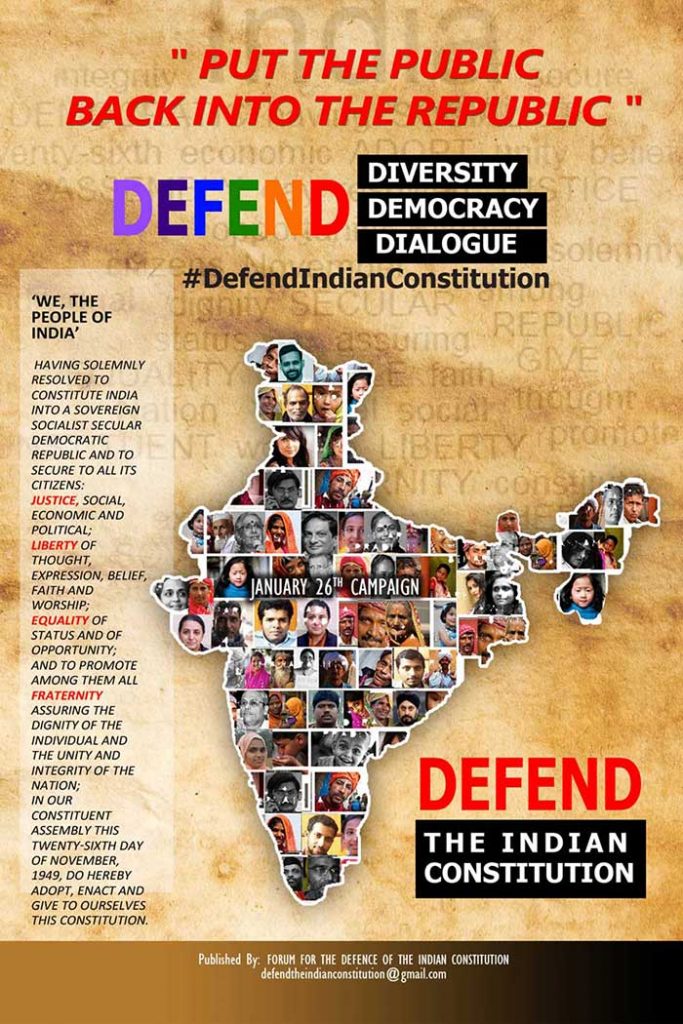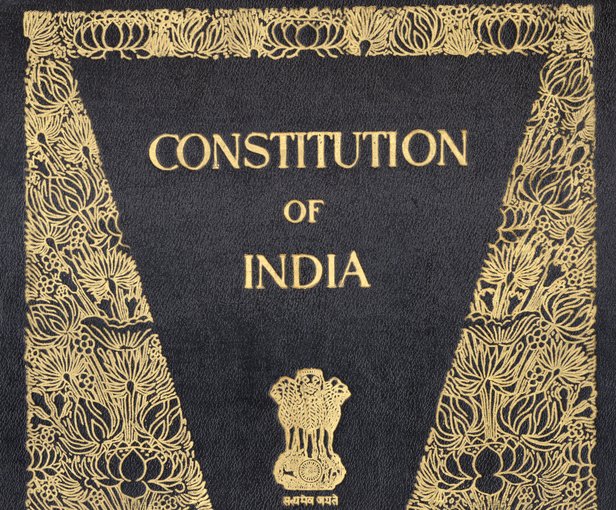
That way reciting the Constitution’s Preamble has been transformed from text to socially dynamic statement…
Against this new method of agitation, authorities slapped various criminal charges including sedition, arrested several protestors and strongly opposed their bail petitions.
***
We celebrated 72nd Constitution Day on 26th November 2021. Two months before Republic Day (26 January 1950), the Constitution was finalised and adopted by the Constituent Assembly on November 26, 1949.
Citizenship rights, right to vote, and several other important aspects of the Constitution have commenced on this day, while all other Articles were notified on January 26, 1950 making India a comprehensive Republic State. Election Commission came into existence on November 26 to take up the first ever gigantic exercise of conducting elections to Lok Sabha and Assemblies of the then provincial states. The first significant basis of Indian democracy as per the Constitution is the universal adult franchise of all those who attained age of 21 years. (The voting age was reduced to 18 years, later).
The Preamble of Indian Constitution has assumed great importance and relevance recently due to the unconstitutional measures of the governments, and people started reciting it as symbol of protest. Since 2020, the public readings of the Preamble besides becoming popular as a form of protest and a reminder to the government to adhere to the principles enshrined in the Constitution. Scores of protests and programmes to oppose the CAA have been marked by protesters holding up copies of the Constitution and public readings of the Preamble. That way the Preamble has transformed from text to socially dynamic statement.
When dalit leader Chandrasekhar Azad has protested Citizenship Amendment Act in 2020 by reading Preamble and flashing copies of Indian Constitution, the Delhi police slapped him with several criminal cases.
The matter reached the Delhi Court for bail. Delhi Court Judge Kamini Lau, while hearing the bail petition of Chandrasekhar Azad, and his call for protests and dharna near Jama Masjid asked, “What is wrong with dharna? What is wrong with protesting? It is one’s constitutional right to protest?” She further asked: “Where is the violence? What is wrong with any of these posts? Who says you cannot protest? Have you read the constitution? You are behaving as if Jama Masjid is Pakistan. Even if it was Pakistan, you can go there and protest. Pakistan was a part of undivided India,” the judge told the prosecutor.
She commented: “In the colonial era the protests were out on the roads. But your protest can be legal, inside the courts. Inside the parliament things which should have been said were not said and that is why people are out on the streets. We have full right to express our views but we cannot destroy our country.”
The judge also added that none of the posts of Azad was unconstitutional and reminded the prosecutor that one had the right to protest. When the prosecutor replied that permission had to be taken for protests, the Judge said “What permission? SC has said repeated use of 144 is abuse (referring to recent Kashmir case decision).”
The Judge also added that she has seen many people who had protested outside Parliament going on to become leaders and Ministers later on. The judge also commented that Azad was a “budding politician” who had the right to protest. “I want you to show me under which law is it prohibited for someone to protest outside religious places”, she asked the Prosecutor.
While giving bail to accused, Judge said: “…for the judges, legal persons and offices under the Constitution, the Constitution is a sacred document and if this is correct, then reading this document cannot prima facie be taken as incitement. The Preamble of the Constitution is a brief introductory statement that sets out the guiding purpose, principles and philosophy of the Indian Constitution”.
The court granted bail to the accused. She observed that while exercising right to peaceful protest, no corresponding right of another is violated, and said: Of course, it goes without saying that protests lead to inconvenience but it has to be ensured that these protests do not last for a long time at public places under public use. In the instant case, the protest call was only for one day and the march was from Jama Masjid to Jantar Mantar.
Judge Lau had heavily criticized the Prosecution for justifying Azad’s arrest on the basis of his social media posts calling for protests. Every citizen has the constitutional right to protest, said the judge. The judge had slammed Tihar jail for failing to provide medical treatment at AIIMS to Azad for his medical condition ‘Polycythemia’. The Court then directed to provide Azad treatment at AIIMS for his special medical condition.
Finally, Judge Dr Kamini Lau stated that she was reminded of reverend patriot Rabindra Nath Tagore, “who is most relevant today”. The judge went on to state that during the colonial era, when British was following the policy of divide and rule, Tagore had visualized a nation where there is no fear in the mind of people and education and enlightenment was attained by all. She then quoted from Tagore’s poem “Where the mind is without fear…”.
When governments make laws or policies in contradiction to Constitutional provisions, people chose to show the copies of Constitution and read Preamble as symbol of protest. Since 2020, these new forms of protest acted as a reminder to the government to adhere to the principles enshrined in the Constitution. That way the Preamble has been transformed from text to socially dynamic statement.
It is stimulating to note that reading preamble in public instilled confidence. That was the objective. People understood that our Constitution says the country is secular and a democratic republic.
Several petitions were filed claiming that the CAA when combined with NRC (National Register of Citizens) becomes a lethal combination as the amendment to it excludes one particular community. It is discriminatory and arbitrary to do so.
The Constitution did not allow anyone, including the government, to divide or distinguish its citizens on the basis of religions and hence what is being done is wrong.
The new law, which grants Indian citizenship to Hindus, Christians, Sikhs, Buddhists, Parsis and Jain refugees from Pakistan, Afghanistan and Bangladesh who entered India on or before December 31, 2014.
New method of agitation
Against this new method of agitation, authorities slapped various criminal charges including sedition, arrested several protestors and strongly opposed their bail petitions.
In that context, Musician T M Krishna says: “The most stunning moments in the protests for me was that every day young people were collecting in public places and reading the Preamble and they were reading it in so many languages—in Tamil, Malayalam, Hindi, Urdu, you name it.” “For the first time, I saw the Preamble coming out of a textbook and being embodied in an act of questioning.
It is in fact just a piece of paper with words, but they became an act that gave meaning to the protests. The people are reclaiming the relevance of those words.
They are reading Preamble with national anthem. Krishna further says: “When you hear the Preamble back to back with the national anthem, then you read the anthem differently. You realize that our culture and our Constitution embody the same values—of a universality of humanity and empathy for each other. There is nothing here to thump one’s chest about. Nothing aggressive about who we are, just inclusive in a gently assertive way”.
Thus, the Preamble itself becomes a social movement. This proved that the ideas can travel from a book into the minds of people, shaping their attitudes and behavior; they can flow into streets and schools and become a social movement. There were demonstrations throughout the nation seeking repeal of CAA and also the withdrawal of three anti-farmer laws.
Preamble recitation is a social movement rediscovering for society the democratic values. The youth, lawyers, and politicians recognized that the Preamble’s message is more relevant than ever before.
***
Courtesy: Hans News Service , 30 Nov 2021
https://www.thehansindia.com/hans/opinion/news-analysis/reciting-preamble-is-not-a-crime-717491
Author Dr. Madabhushi Sridhar Acharyulu was a Professor at Nalsar University of Law in Hyderabad, former Central Information Commissioner and presently is Dean & Professor, School of Law, Mahindra University, Hyderabad.
Email:[email protected]













































